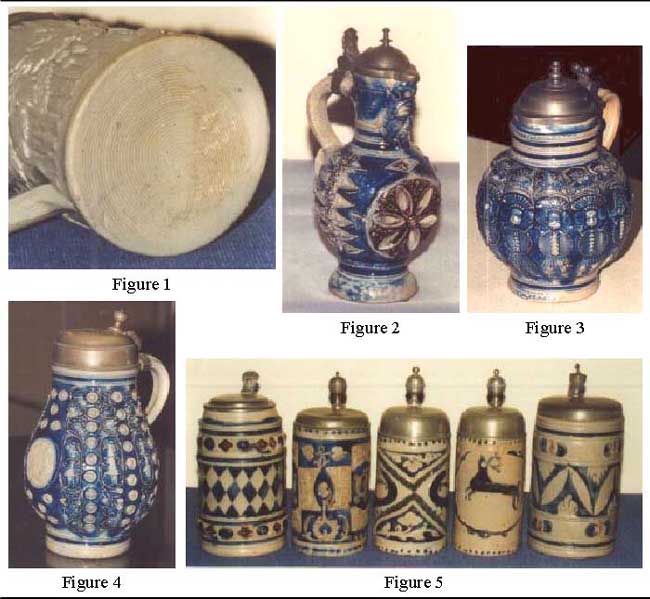
Stoneware goes back to about the 13th century when for the first time kilns could be brought to a temperature sufficient to cause vitrification. Vitrification is when the porous clay actually melts into a non-porous mass. This transformation from clay to stone occurs at about 1,200 degrees centigrade, or 2,200 degrees Fahrenheit. By introducing salt into the kiln at the height of the firing, just after vitrification has taken place, a hard glaze that is actually a type of glass, a sodium-alumina-silicate, is formed on the stoneware surface as the sodium in the salt and the silicates in the clay chemically combine. A proper glaze requires 2.5 kg, or about 5 lb. of salt per cubic meter of kiln space. To keep the salt from accumulating in the vessels, they are fired either upside down or in capsules. The salt glazed stoneware is now impervious to all liquids except hydrofluoric acid. Before the development of stoneware, ceramic vessels had to be given a glaze, usually a lead glaze, so that liquids could not seep through their porous walls. Because stoneware is vitrified and not porous, it does not actually require a glaze, but a glaze is added for aesthetic purposes, and of course it makes the job of cleaning much easier.
The stoneware clays in the west of Germany are white-yellow when they come out of the ground. The clay is finely ground and screened to remove any impurities. The clay is then mixed with quartz and fluxing agents in the following proportions, the exact percentages depending on the actual receipe used by any particular factory: clay, 30-70%, quartz, 30-60% and fluxing agents (lime, magnesia, alkalis) 5-25%. Once the clay has been prepared, it is mixed with water to one of two consistencies depending on the method of production. If plaster molds are to be used, the clay is mixed into a “slurry” that has the consistency of runny cake batter. This is then poured into the mold and the plaster absorbs the moisture out of the slurry, leaving a leathery shell. After an exact amount of time, the excess slurry is poured off and the remaining shell is removed from the mold. At this point, if the stein still needs a handle, it is added and the stein is set aside for a while to dry.
 |
The second method, and the oldest, is to form the stein on a potter’s wheel. The clay is mixed to a thicker, more plastic consistency until a “hump” can be formed. The hump is then placed in the middle of the wheel and a depression that will form the inside of the stein is made in the hump and the sides are drawn up. When the body is complete, it is removed from the wheel by pulling a wire under it. Sometimes a thin knife is used. The wheel is still turning when the stein is separated from the wheel, and drag marks that form a whorl pattern on the bottom are the result. Often these are smoothed away, but sometimes they are left as is. See figure 1. The handle is then added and the stein is set aside to dry.
There is a third method of manufacture, used from about 1840 to around 1905. This method utilized both a mold and the potter’s wheel. Instead of forming the body of the stein on the wheel, the clay was hand-applied to the inside of a three piece iron mold. The clay was then driven into the walls of the mold through the use of a tapered wedge, hammered in with a large wooden mallet. The lack of detail evident on many steins of this type is not the result of worn molds, but is due to the clay being of insufficient thickness to be pressed completely into the deepest recesses of the mold. The body of the stein was then removed from the mold and attached to its bottom on the wheel, and any other finishing touches were done at this time. The body was then removed from the wheel, the handle attached, and the stein was set aside to dry.
When fired, the finished product can emerge from the kiln either light gray or buff, yellow-brown. Both are made from exactly the same clay. In Germany, the light gray stoneware is called “Steinzeug.” It is fired in a reducing, or oxygen-poor atmosphere. The buff colored stoneware is called “Elfenbeinsteinzeug,” or ivory stoneware, and is fired in an oxidizing, or oxygen rich atmosphere. It is the small amount of iron in the clay that gives it its color. However, this article will confine itself to the subject of Steinzeug, the gray stoneware decorated in blue and sometimes purple for which the Westerwald is so famous. Let me repeat that. This article addresses itself only to Steinzeug, because some of the features described in this article do not apply to Elfenbeinsteinzeug.
The stoneware factories of Germany have come and gone over the centuries, each producing wares unique to their area and factory. Before the mid-19th century there was little need to apply a manufacturer’s mark as each was visually identifiable as to its area of origin. The most enduring area of stein manufacture has been the land along the Rhine known, as “Kannenbäckerland,” or Jug Bakers’ Land. The area around Coblenz and Höhr-Grenzhausen is the all time champion of stoneware production. Steins are still being manufactured there today.
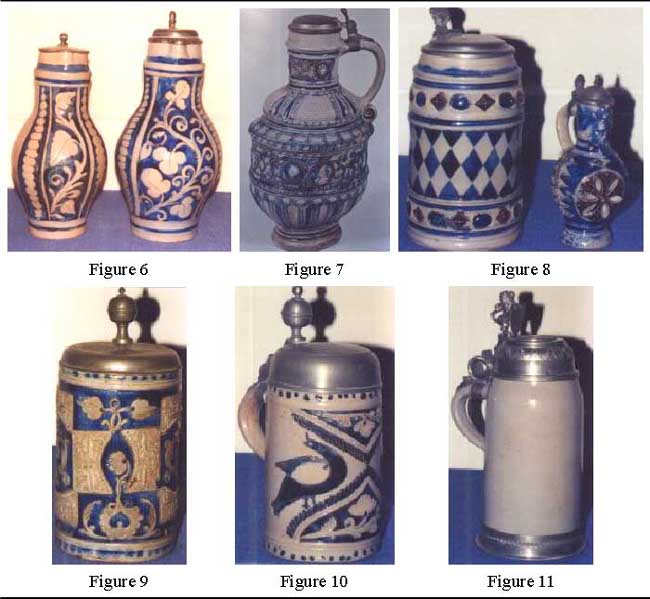 |
Early stoneware production along the Rhine occurred at Cologne/Freschen, Raeren and Siegburg, each producing their distinct wares. Sometime around 1525 or so, we find the first use of cobalt oxide being applied to the stoneware producing the familiar blue and gray stoneware we know so well.
In 1556, Philip II inherited the throne of Spain and along with it several other nations including the Netherlands. Determined to drive out the heresy of the reformed religion, he introduced the Inquisition to the Netherlands. Those who eluded the inquisitors were driven out, and many migrated up the Rhine into the lands of sympathetic rulers. The migration continued until the end of the 30 Years War (1618-1648).
Many of the emigres were potters, some of whom settled in the clay-rich region of the Westerwald. Around 1650, soon after the war ended, the decorators of the Westerwald began applying manganese dioxide to their wares. This resulted in purple being used in concert with the blue, giving an added dimension to the gray stoneware bodies. The jug in figure 2 is c.1650-75 and is decorated with both cobalt oxide and manganese dioxide.
While the Westerwald produced stoneware jugs of numerous sizes and shapes, most of the early ones have been absorbed into permanent collections and are rarely available, see figures 3 & 4. What you are most likely to come across is the common krug, or Bierkrug, with straight sides, about twice as tall as it is wide, as in figure 5. These are usually found in ½ and 1 liter sizes, but 1.5 and 2 liter steins are not uncommon. Large, bellied stoneware jugs, produced after 1865, of 1.5 to 4 liters, are still readily available. See figure 6.
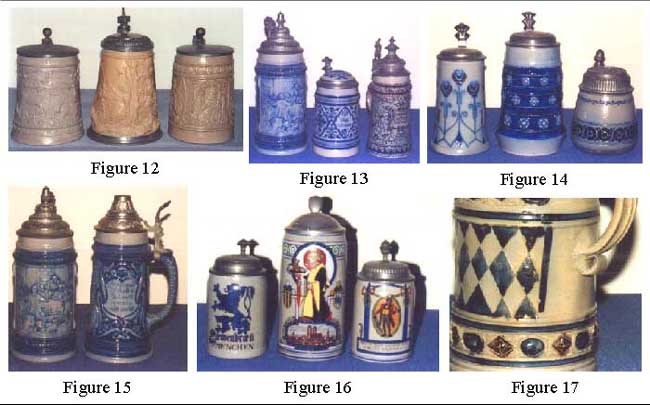 |
Style is the soul of an era. Accumulated knowledge and experience in the areas of religion, philosophy, politics, science, art, industry, commerce and the joys and sorrows of day to day living produce societal tastes at any given moment in history. These, in turn, dictate the style unique to that moment. Styles come and go, some remain longer than others, but once gone they never return. Style can be, and often is, copied, but never exactly duplicated. Something, call it the spirit of the age, is missing. That something is often visible to the eye and yet may elude explanation. It is therefore important that the collector, no matter what they collect, develop an eye for style.
The period in which a stein was manufactured can often be determined by its style. The style of the body, the style of decor, the style of the pewter fittings, even the style of a handle can tell us when a stein was made. Yes, even the handle is a good barometer of age, particularly on Westerwald steins. In the late 19th century quite often the actual factory can be identified from the handle. Because these styles (body, decor, pewter, handles, etc.) changed at different times and their periods of usage overlapped one another, the particular combination of styles can help pinpoint the date of manufacture.
As I pointed out in another article, the most important rule to remember, once you have learned all the rules for dating your steins, is that there are exceptions to every rule. Your thinking along these lines must be flexible, and do not base your assessment of a stein’s age on any one indicator. Use as many as you can recognize, and assuming everything is original, let them lead you where they will.
1600-1650: The Westerwald produced wares very similar to Raeren during this period. As a matter of fact, the products of both areas are sometimes signed by the same artist. For the most part these were jugs containing peasant or religious scenes taken from wood cuts or copper engravings. Raeren used a brown glaze and the Westerwald products were blue and gray. See figure 7.
1650-1720: Decor is primarily cut and applied, in blue, manganese and gray. As noted earlier, manganese was first used about 1650, adding purple to the available palette. Manganese allowed a range of purple from lavender to black. The cuts or incised lines are usually straight, creating zig-zags, diamonds and checkerboard patterns. Applied portions include diamonds, ovals, lacy bric-a-brac and bearded faces. The fronts of the jugs often contain a star or a wheel. See figure 8.
1720-1750: We find manganese falling into disuse and the pieces are now simply blue and gray. Decor is cut, stamped and applied. The applied portions are in gray panels containing animals (deer, horses and rabbits), birds and vines. In and around the panels are cut and stamped patterns of leaves and flowers. See figure 9.
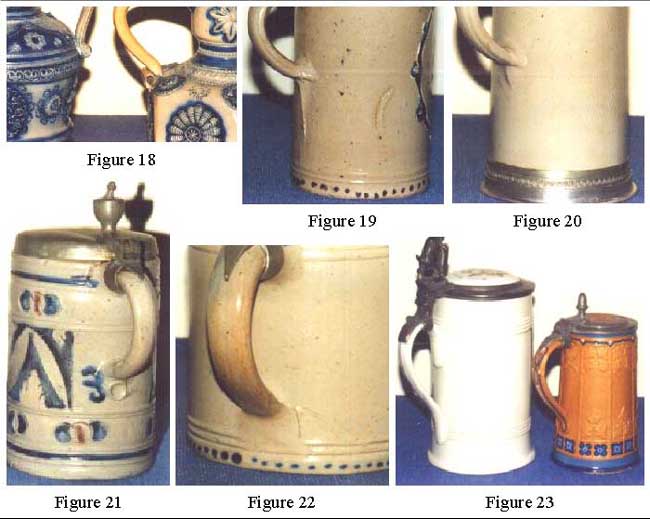 |
1750-1820: Cut, or incised, floral and animal patterns, again birds, deer, horses and rabbits. Colors are blue and gray (see figure 10) except for an unidentified factory that used negligible amounts of manganese as an accent c.1790.
1820-1870: Plain gray, combed bodies, “Bavarian style” ½ and 1 liter steins (see figure 11), often with an over abundance of pewter. The foot rings sometimes extend 30% or more up the body.
1840-1895: Molded relief, plain gray, or light tan Gepresste-Kännchen, or so called “Regensburg” steins. See figure 12. These sometimes have a brown, or pink-brown glaze.
1870-1900: Molded bodies with regular and threaded relief, some have cut or incised decoration added. See figure 13. Blue and purple are the predominant colors, but green and black are also seen.
1895-1914: All major manufacturers turn to jugendstil (see figure 14) and even when a more traditional style stein is made, it contains elements of art nouveau. See figure 15. The “Bavarian” style stein is also in favor especially with transfer and enamel decoration. See figure 16.
1600-1720: During this period we find a curled lower handle attachment. See figure 17. In the early to mid 1870’s the Westerwald firm of Reinhold Hanke and the Regensburg firm of Borho, Zinkl and Co. used a curled lower handle attachment on some of their “Historismus” pieces. See figure 18. There is no need to confuse the two and mistake the newer for the older. Look at the lower handle attachment in figure 17, and you’ll see a small “foot” that extends upward from the point of attachment adding strength. This small foot is not present on the newer “Historismus” pieces.
1700-1820: On most of the steins from this period we find the lower handle attachment pulled down to a spike-like point. See figure 19. The length of the tail pulled down below the handle varies considerably from stein to stein. Figure 20 is the same style handle attachment but notably shorter.
1750-1790: A small blob of clay is left, or added, at the lower handle attachment, that is then impressed with a ball-shaped object, often just a finger. See figure 21. The blue curlicue next to the handle, that looks like a three, is not part of the decor so it must have some other function. It appears to be a capacity mark. The stein holds 1.2 liters, or three, .4 liter measures. If this is so, then this is one of the earliest capacity marks of which I am aware.
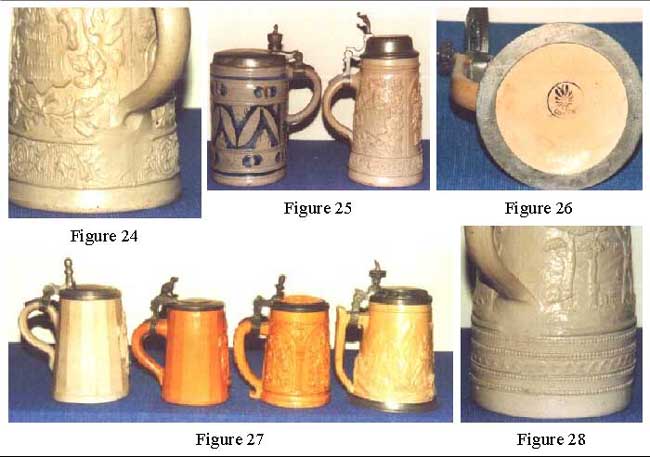 |
1780 to the commencement of World War l: This lower attachment style is usually found on inexpensive, utilitarian type steins such as Gepresste-Kännchen or steins made for breweries and taverns. See figure 22. As this style of attachment was used for such a long time, body, decor and pewter styles are important in determining the age of steins utilizing this style of handle.
1820-1840: While neither of these steins are of Steinzeug, I felt it appropriate to illustrate the handle style from this period. This handle is in the shape of a question mark and is usually a flattened oval strap, rounded at either end. See figure 23.
1865-1885: The handle attachment in figure 24 appears to be a combination of those used in figures 21 and 22. Seen separately by someone new to stein collecting, the handle in figure 24 could be confused with that in figure 21. Seen back to back the difference in handle shape and location is apparent. The one on the left in figure 25 is the earlier piece. Note the handle attachment locations. The steins manufactured in the Westerwald can be divided into two groups based on handle location. Those manufactured before the hiatus in stoneware stein manufacture, which occurred about 1830, and its resumption on a full time basis about 1865. During those 35 years, production was sporadic and the quantities produced were very low. On the older steins, the upper handle attachment is just below the rim and the lower attachment is at the mid-point of the body. The handle is located so high that there is no room for a shank and the hinge sits almost directly on the handle strap. When a shank is present on these early pieces, it is usually because there is a lid ring that causes the lid to sit at a higher elevation. Otherwise, we begin to see a shank appear on some Westerwald “Gepresste-Kännchen” steins as early as about 1845-50. On the newer steins the upper handle attachment is lower and the bottom handle attachment is two-thirds to three-fourths of the way down the body. There is a definite shank between the handle strap and the hinge.
When stein production resumed on a full time basis around 1865, many of the steins being made were the just mentioned “Gepreste-Kännchen” we have come to know as “Regensburg” steins. Recent research by Werner and Irmgard Endres has shown that the majority of these steins were actually produced in the Westerwald by some 15 different firms. While it seems certain that the Regensburg factory of Borho, Zinkl, Thenn produced a number of these steins, the term Regensburg, in referring to them, is no longer appropriate. This type of stein originated in the Westerwald, and because they fit into a proper sequential lineage of Westerwald products, they should be referred to simply as Westerwald steins. There are over 70 different scenes used on these Gepresste-Kännchen.
The earliest of these Gepresste-Kännchen appear to have been made by the H.J. Krebs factory in Valendar near Coblenz. They apparently began producing these steins about 1841. By 1850, or so, it had become the I.H. Krebs factory. Their mark on the bottom of these pieces is the earliest stoneware factory mark of which I am aware. See figure 26. The steins in figure 27 are all from the Krebs factory and left to right are, c.1841-45, this piece is totally unglazed, a piece of “bisque” stoneware. Note also the “question mark” handle. 1850-55, gray stoneware, with a light brown glaze; 1855-65, again, gray stoneware, and the glaze is a pink-brown; and 1875-85 a typical, clear salt glaze is used. Note the different handle designs on each of these pieces. While the Krebs factory used a variety of handles, the handle style used by other factories on the overwhelming majority of Gepresste-Kännchen, is that in figure 28. Production of Gepresste-Kännchen had nearly ceased by 1890, but the Reinhold Merkelbach factory was still producing some as late as1905.
The late 1860s and early 1870s saw the startup of numerous stoneware factories that once again produced all kinds of table and decorative ware in the familiar gray and blue of the Westerwald, and lucky for us, steins were one of the products they turned out. Some of the factories that were major producers of Steinzeug were Reinhold Hanke, Reinhold Merkelbach, Simon Peter Gerz, Merkelbach and Wick, Marzi and Remy, and to a lesser degree Duemler and Breiden and Matthias Girmscheid. While many of these steins are without a manufacturer’s mark, we can often recognize the source through the style of handle that was used.
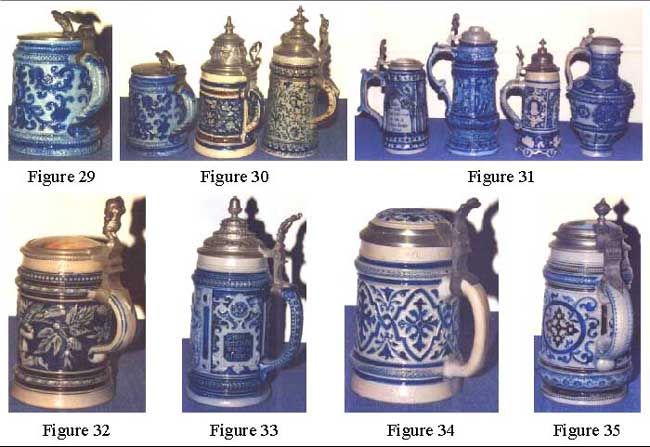 |
The handle in figure 29 is one of the most common, and virtually identical handles were used by at least three different factories, Reinhold Hanke, Simon Peter Gerz and the Regensburg factory of Borho, Zinkl, Thenn. These handles are so alike, that seen separately, they can easily be confused with one another. Figure 30 illustrates the differing styles of these factories, from left to right, Hanke, Gerz and Thenn. I mention and illustrate the Regensburg factory so there will be less chance of mistaking them for products of Hanke or Gerz. The handle decoration on these three is the norm for these factories, so can usually be used as an identifying factor. Note the handle on the Hanke piece; it is completely blue. While you may occasionally find Hanke wares in blue and gray, you will more than likely find them as blue on blue because the color on Hanke steins is often diffused over the entire surface. The colors on Gerz steins are well defined and separated. The difference in the handles is obvious. There should be no mistaking these two factories. While not as pronounced as the Hanke wares, those from Regensburg also have a slight blue cast to the bodies. The differentiating factor here is the use of manganese. While the Hanke factory virtually never used it except on character steins, the Regensburg factory regularly used manganese as an accent. Their handles often have blue down the middle with purple down the outer edges.
In 1868, two major milestones occurred in the life of Reinhold Hanke: he married Maria Josefa Krebs, and he opened his own stoneware factory. Perhaps the penchant of the Krebs factory for using “different” handles rubbed off on him because the steins in figure 31 are all from the Hanke factory, and this is just a small sample. Actually, a person would be hard pressed to single out just one handle that might be representative of the Hanke factory.
However, there were a large number of factories producing stoneware in the Westerwald, and many of them produced steins in some quantity. A few factories, due to the exclusive use of a certain style handle, can be recognized from these handles even if they carry no factory marks. Here are a few examples. The handle in figure 32 is from the Merkelbach and Wick factory. The handle in figure 33 that looks like a snake’s belly with a stripe is from the Reinhold Merkelbach factory. The handle in figure 34 is usually known as the “Black-Topped Handle,” except when found on blue and gray saltplaze steins and is a product of the Marzi-Remy factory. The stein in figure 35, while not from the Westerwald, is usually found marked, but in case it isn’t. It’s from the Hauber und Reuter (HR) factory.
Finally, exclusive features of decor, and designers’ initials, can also be used to determine a stein manufacturer, but those will have to wait for another article.
__________
*Reprinted by permission from Prosit, the Journal of Stein Collectors International, Vol 2, No. 18, June 1996